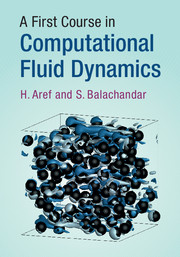Book contents
- Frontmatter
- Contents
- Preface
- 1 CFD in Perspective
- 2 Mappings
- 3 Ordinary Differential Equations: Initial Value Problem
- 4 Spatial Discretization
- 5 Boundary Value and Eigenvalue ODEs
- 6 Methods Based on Functional Expansions
- 7 Partial Differential Equations
- 8 Multi-dimensional Partial Differential Equations
- References
- Index
1 - CFD in Perspective
Published online by Cambridge University Press: 03 October 2017
- Frontmatter
- Contents
- Preface
- 1 CFD in Perspective
- 2 Mappings
- 3 Ordinary Differential Equations: Initial Value Problem
- 4 Spatial Discretization
- 5 Boundary Value and Eigenvalue ODEs
- 6 Methods Based on Functional Expansions
- 7 Partial Differential Equations
- 8 Multi-dimensional Partial Differential Equations
- References
- Index
Summary
Computational fluid dynamics, usually abbreviated CFD, is the subject in which the calculation of solutions to the basic equations of fluid mechanics is achieved using a computer. In this sense, CFD is a subfield of fluid mechanics, but one that relies heavily on developments in fields outside of fluid mechanics proper, in particular numerical analysis and computer science. CFD is sometimes called numerical fluid mechanics.
It is a prevailing view that the computer revolution has produced a “third mode” of scientific investigation, often called scientific computing or computational science, that today enters on a par with the more established modes of (theoretical) analysis and (laboratory) experimentation. CFD is this new “third mode” of doing fluid mechanics.
The Nature of CFD
Our objective is to explore CFD from a basic science perspective. We take as a given the power and elegance of analytical reasoning in fluid mechanics, and the precision and persuasiveness of well-executed experiments and observations. We wish to demonstrate that CFD has ingredients from both these traditional ways of doing fluid mechanics, and, furthermore, injects a set of unique viewpoints, challenges and perspectives. The subject has many very new aspects, due in large part to the rapid and recent development of computer technology. Yet it also has considerable historical and intellectual depth with many contributions of great beauty and profundity that derive directly from cornerstone developments in mathematical analysis and physical theory.
There is often a very special flavor to a CFD investigation. Sometimes this arises from the unique combination of trying to describe a continuum using a finite set of states (and, thus, ideas from discrete mathematics). On other occasions one has the challenge to address a question that is still too difficult for conventional analysis and is largely inaccessible to laboratory experiments. An example of this kind is whether the three-dimensional Euler equations for incompressible flow generate singularities in a finite time starting from smooth initial data. In a computation we can often impose a constraint or symmetry that is very difficult to achieve or maintain experimentally, such as exactly two-dimensional flow. In a computation we can increase the nonlinearity in the problem gradually, from a regime conforming to a linearized description, that is usually amenable to analysis, to a weakly nonlinear regime (where analysis typically is much harder), and finally, to a fully nonlinear range (where analytical understanding may be altogether lacking).
- Type
- Chapter
- Information
- A First Course in Computational Fluid Dynamics , pp. 1 - 34Publisher: Cambridge University PressPrint publication year: 2017



